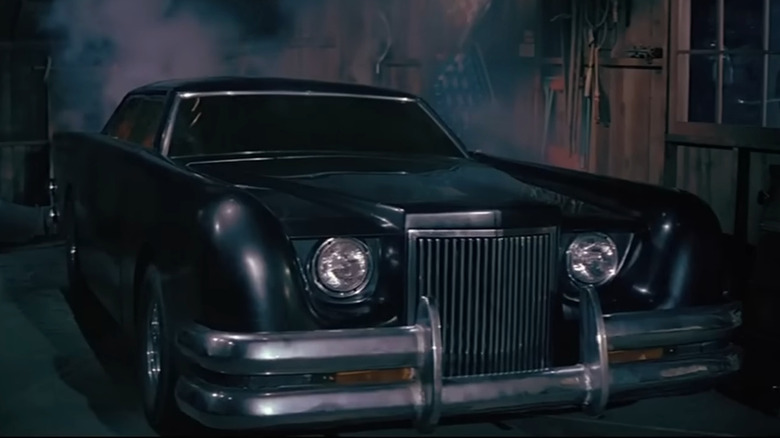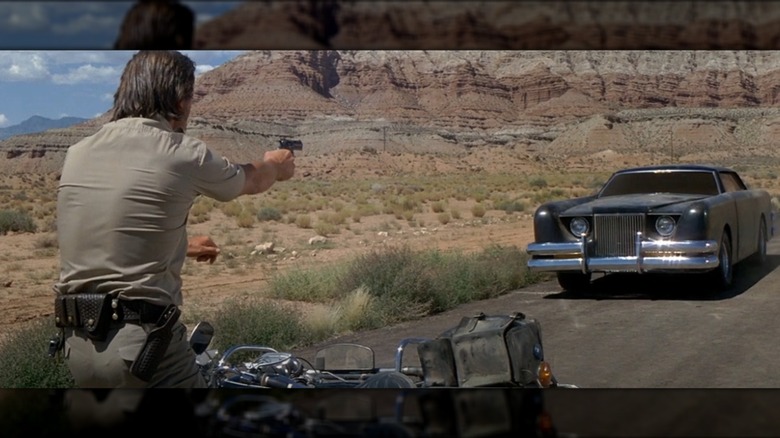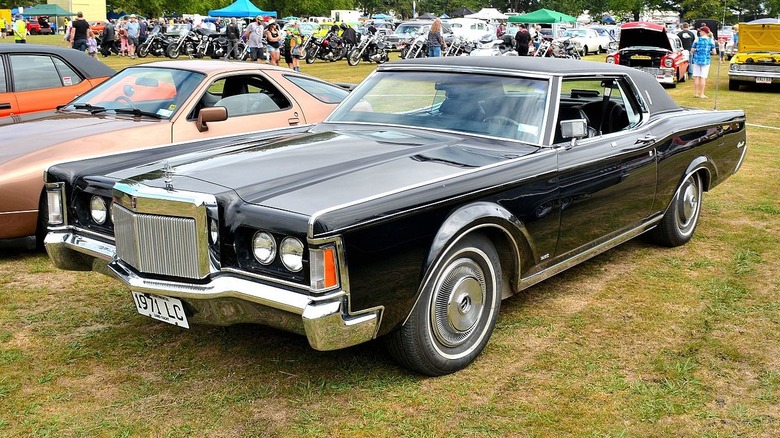What Happened To The Automobile Used In 1977's The Car & What Kind Was It?
Automobiles and Hollywood go together like peanut butter and chocolate. From the many variations of the Batmobile to the time-jumping DeLorean, James Bond's gadget-laden Aston Martins, and the 1968 Ford Mustang GT in the movie "Bullitt," cars have been and always will be as pop-culturally impactful as the award-winning actors and actresses who star beside them.
Then you have the spooktacular line of films that feature vehicles possessed by some otherworldly entity or helmed by a psychotic driver. In 1971, Steven Spielberg (yes, that Steven Spielberg) directed a made-for-TV movie called "Duel" where a massive tractor-trailer chases after a commuter. In 1974, an ancient life-form on a small Pacific Island takes over a piece of construction equipment and becomes a "Killdozer."
And, of course, you have two of the all-time great Stephen King killer machines. The star of the 1983 film "Christine" was a red 1958 Plymouth Fury, while 1986 not only gave us Emilio Estevez fighting a semi-truck monstrosity with a huge Green Goblin head in "Maximum Overdrive," but we also got to see Estevez's brother Charlie Sheen starring as a cosmic spirit in "The Wraith," driving a Dodge M4S Turbo Interceptor — one of the handful of movie cars that actually exist.
A film that tends to get overlooked by the general public is one released in 1977 simply called "The Car," which featured a custom-designed ride possessed by a phantom, a demon, or maybe even the Devil himself (which was the film's tagline). Under the sinister veneer sat a 1971 Lincoln Continental Mark III.
The Car was meant to be Jaws on land
"The Car" starred a young James Brolin (the father of Josh Brolin, also a big film star) as the local sheriff tasked with stopping ... the car. It had a cast that included several familiar (at the time) Hollywood faces, such as Kathleen Lloyd, John Marley, John Rubinstein, Ronny Cox, and R.G. Armstrong. Directed by the award-winning Elliot Silverstein, it might have been a much bigger hit if not for timing. Okay, probably not, but it has since become a cult classic.
You see, it was released in theaters on May 13, 1977 (which was a Friday, so nice touch there), just 12 days before a little film called "Star Wars" took the world by storm on May 25. Making matters worse, two days later "Smokey and the Bandit" hit silver screens on May 27, which featured its own iconic car. Needless to say, "The Car" was quickly forgotten in the annals of Hollywood history.
Interestingly, director Silverstein was mandated to make a land-based version of the hit 1975 film "Jaws," so the ominous vehicle had to look the part. Four cars were made for the film (each for a specific purpose), and famed Hollywood car designer George Barris, the go-to car guy in Hollywood, created the original look. He also made the automobiles for "The Munsters," "Batman," "The Dukes of Hazard," "Knight Rider," and more.
The film's co-writer, Michael Butler, thought a rusty, beat-up 1953 Mercury missing some chrome would make for the perfect car. Barris had another idea entirely.
The luxurious Continental was converted into one creepy ride
Barris took a 1971 Lincoln Continental Mark III, raised the body to the upper doorline, and chopped 3 to 4 inches off the top (sources vary on how much was cut off). The black transparent windows made it impossible to see into the car, while interior shots looking out had an amber filter attached, all of which combined to make the car even more sinister.
Twenty-gauge steel was placed over the original fenders, and a custom-built grill was created using square steel tubing. Barris opted for two huge single 7-inch headlights instead of the Continental's original standard pair on either side of the grill. Four chrome bumpers made from heavy 18-gauge steel wrapped the front and rear of the vehicle, giving the front an almost fang-like appearance.
This all sat on top of a heavy-duty suspension powered by the Ford 385 series big-block 460-cubic-inch V8 that produced 365 horsepower, one of the biggest V8s Ford ever built. Four Goodrich tires (or wide Mickey Thompson Sportsman tires, again, depending on the source) were mounted on chrome Cragar wheels, and the car's menacing appearance was finished off with 20 coats of black pearl lacquer. The final customization effort made the vehicle look evil in all the right ways (albeit a little amateurish by today's standards), especially the front, which bore a striking resemblance to a face, complete with unblinking wide eyes set under a furrowed devilish brow (and don't forget about the fangs).
[Featured image by GPS 56 via Wikimedia Commons | Cropped and scaled | CC BY-SA 2.0]
A sinister mystery wrapped in black pearl lacquer
Some sources claim the "hero" car used for close-ups was the only steel-made vehicle, while the three used for jumps, crashes, and high-speed chases were constructed using fiberglass. However, other sources claim all four were made from steel. Whatever the case, the cars were said to cost about $84,000 and took roughly eight weeks to assemble.
The driver's seat had a safety harness and a full-body roll cage to protect the driver. In the passenger's seat sat a steel-tube cannon. When a scene called for a car roll, the stunt driver pressed a button, igniting dynamite. The resulting blast sent a section of telephone pole into the ground, causing it to roll. Another of the stunt cars was equipped with a speed-enhancing air-breathing ramjet engine.
It's hard to imagine that any of the stunt cars survived, but here's where information gets wonky. Jay Leno says all three of them were destroyed, and other sources claim at least one managed to survive along with the hero car, which is reportedly in the possession of an anonymous private collector who loves film cars. It will sometimes mysteriously appear at conventions and car shows; otherwise, its whereabouts (and owner) remain unknown.
Then you have the replica-tribute cars. Renowned filmmaker Guillermo del Toro reportedly owns one, and after the film was released, a promotional vehicle was built by none other than George Barris himself. More confounding, this source claims all the film-used cars were destroyed. Ultimately, we're left with a B-movie cult classic to enjoy, starring a sinister mystery wrapped in black pearl lacquer that joins the list of iconic movie cars that weren't even real.


